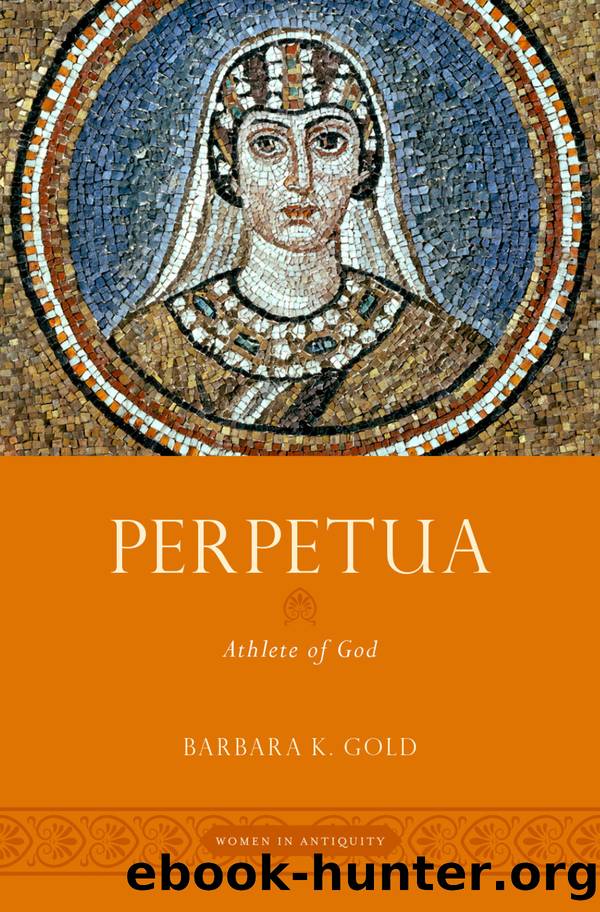Perpetua by Barbara K. Gold;

Author:Barbara K. Gold;
Language: eng
Format: epub
Publisher: OUP Premium
Published: 2018-06-15T00:00:00+00:00
The Men in the Passio: The First Containment of Perpetua
Of the twenty-seven people mentioned in the Passio, twenty-three are men.26 Four of these were fellow martyrs: Revocatus, Secundulus, Saturninus, and Saturus; Saturus, who gave himself up later, was probably Perpetuaâs teacher and is said to be the author of Passio 11.2â13. Perhaps the most important man in her narrative, though not one of the twenty-seven characters and not named, was her editor. We may imagine that Perpetua dictated her visions and thoughts to one of her visitors in prison, perhaps this editor, who then rewrote what she had conveyed to him and subsequently added the framing narrative. This editor thus had the opportunity to shape Perpetua as he wanted to in his sections of the narrative; it is he who has the final word on her martyrdom and death.
Several male figures occur in the four visions that comprise most of her portion of the narrative. In the first vision (Passio 4), in which she steps on the head of a serpent and climbs a ladder, she sees in an immense garden a godlike figure; her next two visions (Passio 7â8) concern her dead younger brother, Dinocrates; and her final and fourth vision (Passio 10), on the day before her execution, features several male figures. Pomponius, a deacon who had visited her in prison (Passio 3), comes in this vision to fetch Perpetua and bring her to the amphitheater.27 He leads her there, pledges that he will assist her, and then departs. Perpetua then sees an Egyptian âhideous in appearanceâ (Aegyptius foedus specie, Passio 10.6) with whom she is to do battle; this Egyptian presumably stands for the Devil, who was, she claimed, to be her true opponent the next day in her actual contest.28 Then another man appears, a paternal figure as in her first vision, so tall that he stood above the highest point of the amphitheater. He was clothed in purple robes and carrying a rod like an owner and trainer of gladiators (lanista, Passio 10.8). This man is a Christ figure, there to present her to die in the amphitheater just as an agônothete or director of the games might present gladiators in the pagan games. After Perpetua wins her fight against the Egyptian and takes the prize, the lanista says to her, âPeace be with you, daughterâ (Passio 10.13).
The narrative also contains a number of other male figures who operate outside of her visions and control Perpetuaâs actions in various ways, although she often fights back and holds her ground. The most important figure, and the one who appears most often, is her father, who visits her four times (three of those in prison) in an attempt to get Perpetua to recant her faith (Passio 3.1â3, 5; 6.1â5, 9). Perpetua firmly resists his pleadings, even engaging him in a philosophical debate (Passio 3) and watching him be beaten by the procuratorâs guards (Passio 6) without yielding her resolve.
Perpetua is clearly a leader among her group of fellow martyrs.
Download
This site does not store any files on its server. We only index and link to content provided by other sites. Please contact the content providers to delete copyright contents if any and email us, we'll remove relevant links or contents immediately.
Fanny Burney by Claire Harman(26249)
Empire of the Sikhs by Patwant Singh(22774)
Out of India by Michael Foss(16695)
Leonardo da Vinci by Walter Isaacson(12810)
Small Great Things by Jodi Picoult(6691)
The Six Wives Of Henry VIII (WOMEN IN HISTORY) by Fraser Antonia(5241)
The Wind in My Hair by Masih Alinejad(4850)
The Crown by Robert Lacey(4578)
The Lonely City by Olivia Laing(4572)
A Higher Loyalty: Truth, Lies, and Leadership by James Comey(4559)
The Iron Duke by The Iron Duke(4126)
Millionaire: The Philanderer, Gambler, and Duelist Who Invented Modern Finance by Janet Gleeson(4112)
Sticky Fingers by Joe Hagan(3916)
Papillon (English) by Henri Charrière(3914)
Joan of Arc by Mary Gordon(3790)
Alive: The Story of the Andes Survivors by Piers Paul Read(3738)
Stalin by Stephen Kotkin(3730)
Aleister Crowley: The Biography by Tobias Churton(3429)
Ants Among Elephants by Sujatha Gidla(3282)
